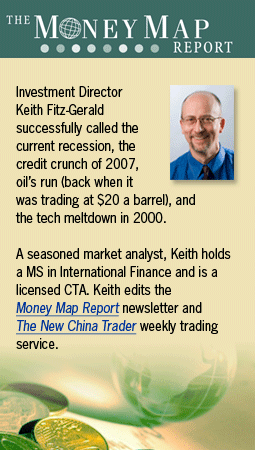By Keith Fitz-Gerald
Investment Director
Money Morning/The Money Map Report
After zooming about 7% from mid-July to mid-August, U.S. stocks have dropped about 5% – a whipsaw-pattern decline that was punctuated by the 2.99% sell-offs in both the Dow Jones Industrial Average and Standard & Poor’s 500 Index yesterday (Thursday).
But none of that’s a surprise for Money Morning readers: Since the U.S. stock market began its now-aborted rally in the middle part of July, we’ve consistently repeated three messages:
- The market rally isn’t sustainable.
- The global credit crisis isn’t over – and the worst is likely still to come.
- And don’t be discouraged: In spite of the economic gloom, and despite the challenge of these highly volatile markets, there are still plenty of profit plays available – they’re just not where investors were expecting to find them.
Subsequent events have proven us correct on the first two points: The market rally has sputtered and stalled, and rising LIBOR (London Interbank Offered Rate) rates tell us that there are additional banking troubles to come – a development we first reported in January, and analyzed again in April, making us among the very first to recognize this as a signal that the credit crisis was worsening.
Indeed, the evidence continues to mount that what started as a mortgage-market credit crisis may actually be the biggest financial crisis to grip the global financial markets since the Great Depression.
Given that market events are playing out as we expected and historical patterns remain intact, we’re confident that our third prediction also will come true – that investors will find solid profit plays to make. But credit-crisis investing demands a special mindset, and a careful adherence to a very specific set of guidelines
Here’s a credit crisis update:
- Legendary PIMCO manager William H. “Bill” Gross is pleading for unprecedented intervention to avoid a catastrophic “financial tsunami.” This represents a change in his tenor and may be self-motivated – at least in part – by the billions of dollars in junk debt his funds are holding, but it’s a change nonetheless. And that makes it worth noting.
- The dollar LIBOR has reached a four-month high, according to the British Bankers Association and the interbank costs of borrowing both short-term euros and dollars continue to edge higher. This suggests banks still don’t trust each other and continue to foresee higher, rather than lower, risks ahead. Remember that higher interest rates reflect higher risks.
- Primary dealers hit the U.S. Treasury with $45 billion worth of bids for only $25 billion worth of Treasuries – or nearly twice as much as the U.S. Federal Reserve was prepared to sell. This suggests that banks are still cash-strapped and that they have nowhere else to turn.
- U.S. regulators, including the Federal Deposit Insurance Corp. (FDIC), are increasingly worried enough about their own finances that they are hatching plans to raid the Treasury’s coffers at a time when the list of trouble institutions is rising at the fastest rate since the U.S. Savings & Loan Crisis.
- Banks are now borrowing primary credit to the tune of a record $18.98 billion per day from the Fed – up from $18.47 billion per day only a week ago.

So, how do we translate this insight into actions that minimize losses and position us for profits? Here are four steps to take immediately – call them rules for credit-crisis investing – that will help you avoid the stock market’s undertow:
- Don’t be rash – especially right now: Some analysts are calling for additional declines, so the temptation might be to either bail out of the markets completely, or, if you’re already on the sidelines, to stay there. Not only does market history demonstrate beyond a shadow of a doubt that this is a mistake, but bailing out provides investors who do so with an even bigger quandary (and possible risk) – when to buy back in.
- With uncertainty comes opportunity – take advantage of the turmoil by rebalancing your portfolio: Many investors have enjoyed large run-ups in their energy holdings, or have disproportionately large positions in gold, natural resource/commodity shares, or even bonds, for instance. While it feels great to sit on large gains, the problem is that you’ll miss out on the huge gains that the market rebound will bring. The reason: It’s the shares that are now classified as “downtrodden” that will generate some of the biggest gains. So it makes sense to pare down your winners and rebalance into those laggards, since they may actually represent more-promising opportunities.
- Quality rules: However, just because stocks are cheap, doesn’t mean they’re not garbage. A key to successful credit-crisis investing is to confine new money to conservative choices with superior fundamentals, positive earnings and expanding revenue. Most of these profit plays are based overseas, with the bulk of them concentrated, not surprisingly, in Asia. Many such companies are still experiencing double-digit – or even triple-digit – growth, despite the U.S. and European slowdowns. While those shares could drift even lower in the near term, history demonstrates time and again that, over the long haul, growing companies sport higher valuations and higher share prices, drawing investors to them like fresh apple pie attracts hungry children. That intrinsic value gives such stocks strength – even during a down market.
- Make sure your foundation is strong: We call them “Base Builder” investments, because they’re strong enough to weather a rough market storm – without sacrificing upside even in a down market. Two favorites – which we’ve talked about before here in Money Morning – are the Vanguard Wellington (VWELX) mutual fund, and the Rydex Inverse S&P 500 Strategy Fund (RYURX). The former is designed to generate upside profits while providing downside protection, while the latter is about hedging, since it’s a so-called “inverse” fund that gains in value as the broad market declines.
News and Related Story Notes:
- Money Morning Market News:
Weak Labor Market and Slowing Retail Sales Put U.S. Stocks in a Tailspin. - Money Morning Market Analysis:
Why Today’s Bull Market is Tomorrow’s Bear Trap. - Money Morning Economic Analysis:
The Three Signs That the Credit Crisis Has Yet to Hit Bottom. - Money Morning Investigative Series:
Outlook 2008: Seven Ways to Profit From the U.S. Dollar’s Doldrums. - Money Morning Market Analysis:
LIBOR Sends Another Shaky Signal to the Global Financial Markets. - Wikipedia:
London Interbank Offered Rate. - Wikipedia:
The Great Depression. - Money Morning Market Commentary:
FDIC Quandary Could Stick U.S. Taxpayers With the Tab for the U.S. Credit Crisis. - Wikipedia:
Savings and Loan Crisis. - British Bankers’ Association:
Web Site.
About the Author
Keith is a seasoned market analyst and professional trader with more than 37 years of global experience. He is one of very few experts to correctly see both the dot.bomb crisis and the ongoing financial crisis coming ahead of time - and one of even fewer to help millions of investors around the world successfully navigate them both. Forbes hailed him as a "Market Visionary." He is a regular on FOX Business News and Yahoo! Finance, and his observations have been featured in Bloomberg, The Wall Street Journal, WIRED, and MarketWatch. Keith previously led The Money Map Report, Money Map's flagship newsletter, as Chief Investment Strategist, from 20007 to 2020. Keith holds a BS in management and finance from Skidmore College and an MS in international finance (with a focus on Japanese business science) from Chaminade University. He regularly travels the world in search of investment opportunities others don't yet see or understand.



